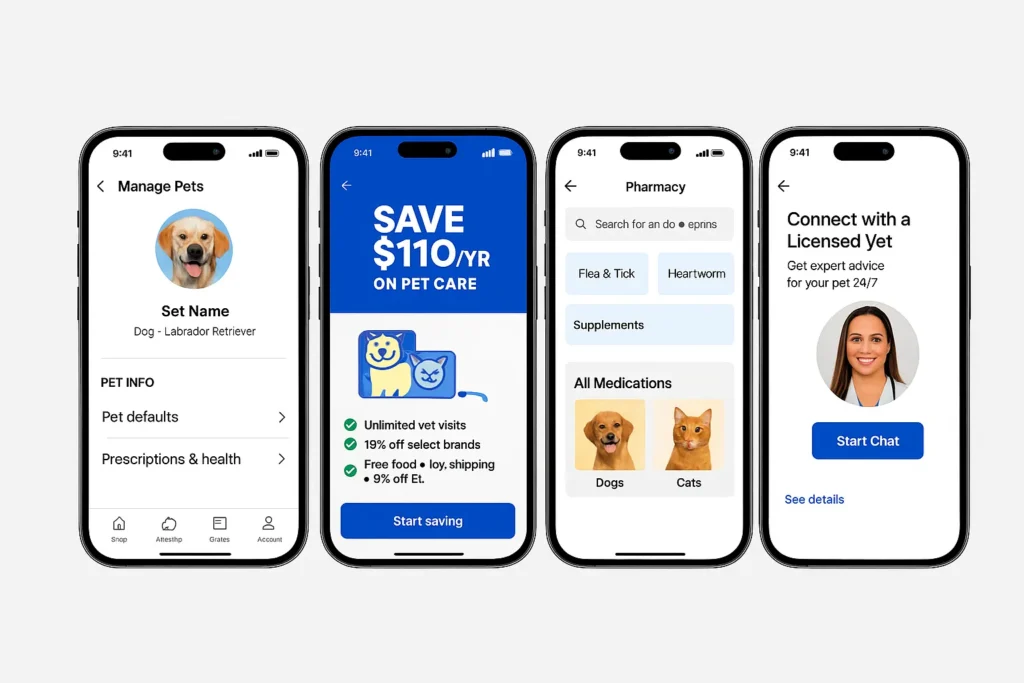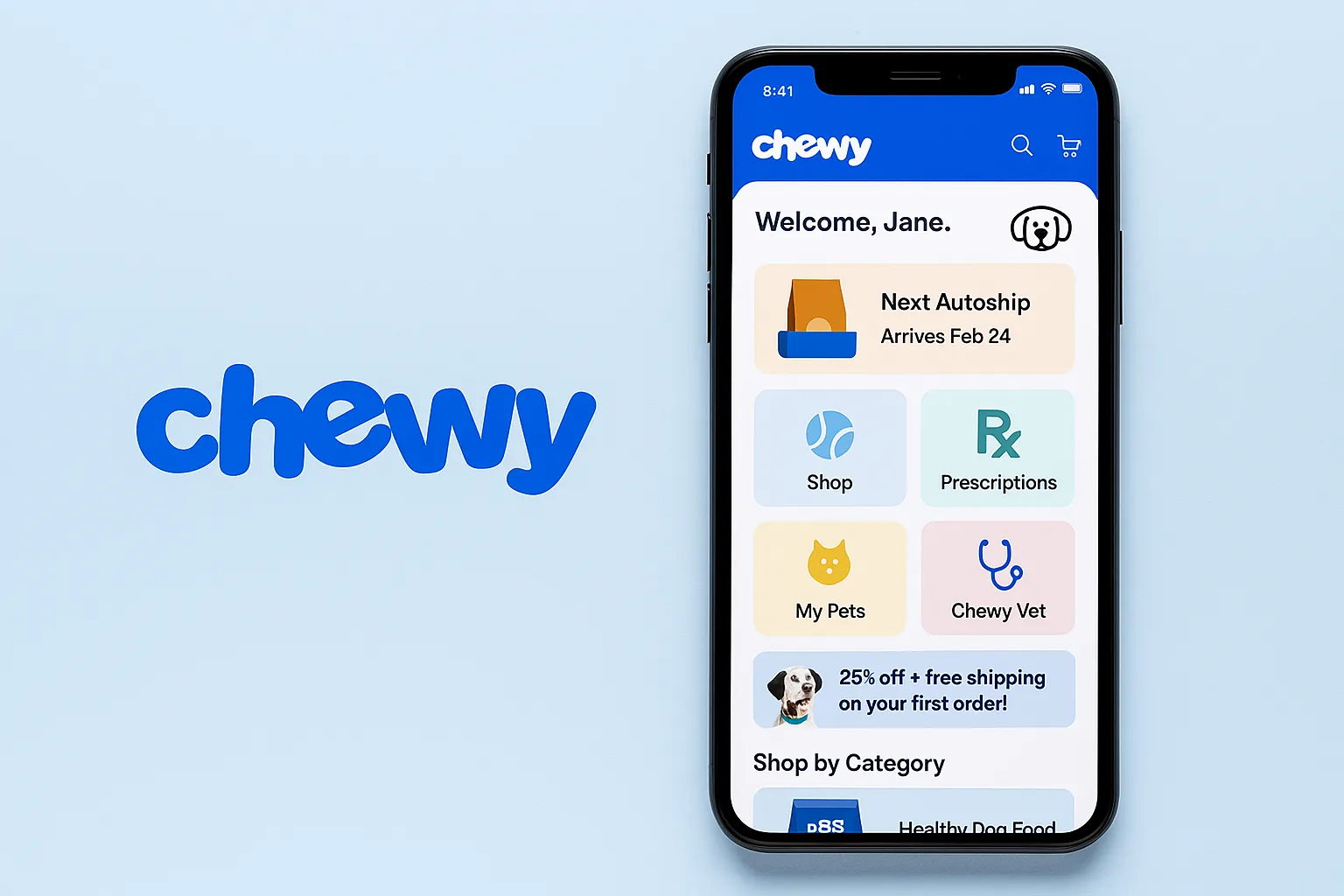Picture this: you’re juggling a busy schedule, your dog’s food is running low, the cat’s litter box hasn’t been refreshed — and you realise you forgot to order supplies. With just a few taps on the Chewy app, your pet’s essentials are en route to your door, scheduled to arrive right when you need them. That’s the kind of problem this app solves: making pet-care logistics frictionless for busy pet parents.
Chewy started in 2011 in the U.S. as an online pet-food and pet-product retailer, founded by Ryan Cohen and Michael Day. Over time the company expanded into subscriptions (automatic shipments for pet supplies), deep customer service, and mobile-app engagement. Fast forward to 2025 and Chewy has over ~20.8 million active customers in Q1, with net sales per active customer at about US$583. It’s no longer just a pet-supply store—it’s a digital pet-care ecosystem.
What Is Chewy? The Simple Explanation
Chewy is a U.S.-based e-commerce and mobile app platform dedicated to pet products and services—from dog food and cat toys to veterinary telehealth and pet insurance. It’s built around one simple idea: making pet ownership easier and more delightful by letting you order everything your furry (or feathery, or scaly) friend needs from one trusted source.
The Core Problem It Solves
Before Chewy, pet parents had to visit multiple stores or websites for different brands and specialty items. Chewy solved that by centralizing all pet supplies with quick delivery, autoship options, and exceptional customer service—removing friction and saving time.
Target Users and Use Cases
- Pet owners across the U.S. who want fast, reliable delivery of food and supplies.
- Multi-pet households needing subscription-style “Autoship.”
- Pet parents seeking vet-approved diets and prescriptions online.
- Users looking for 24/7 chat with certified veterinarians via “Connect with a Vet.”
Market Position (2025 Stats)
As of 2025, Chewy maintains over $11 billion in annual revenue, 20.8 million active customers, and an average spend of $583 per customer. It dominates more than 35 % of U.S. online pet-supply sales, ahead of competitors like Amazon Pets and Petco.
Why It Became Successful
Chewy’s rise stems from its obsessive focus on customer care—handwritten cards, lightning-fast refunds, and compassionate support during pet loss. Its personalized user experience, subscription-based delivery, and emotional brand storytelling built unmatched loyalty in the pet-care industry.
Read more: How to Develop a PetCare Service Marketplace App in 2025
How Does Chewy Work? Step-by-Step Breakdown
For Users
1. Account creation process
- Download the “Chewy: Pet Shopping & Delivery” app from the iOS App Store or Google Play.
- Sign up using your email, create a password, add your shipping address and payment method.
- Optionally set up a “Pet Profile” for each pet (type of pet, breed, age, health needs) so recommendations can be personalised.
- You’re ready to browse, shop and/or setup recurring orders.
2. Main features walkthrough
- Browse product catalogue: thousands of brands and tens of thousands of items across pet-food, supplies, toys, accessories.
- Search or filter by pet type (dog, cat, reptile, fish, bird, horse) and by category (food, treats, meds, bedding, accessories)
- Add items to cart. At checkout you can choose a one-time purchase or set up a recurring “Autoship” delivery.
- Track shipments in-app, receive notifications for order status and shipping updates.
- Access extra services: a pet pharmacy for prescription meds, “Connect with a Vet” support, product reviews & community features.
3. Typical user journey (with example)
Imagine Jane has a 2-year-old Labrador named Bingo.
- She opens the app and sees a reminder that Bingo’s food supply is running low.
- She searches “large breed dog food” → chooses his favourite brand → adds it to cart.
- At checkout she opts for Autoship every 30 days (so she never runs out). She gets a 5% discount on eligible items thanks to Autoship.
- A few days later the order ships; she tracks it via the app; it arrives next day.
- When Bingo has a skin issue, she opens the “Connect with a Vet” chat, sends a photo, gets advice. (Service offered by Chewy.)
- Because Jane is pleased with the smooth experience and personal touches (e.g., customer support), she remains a loyal customer and adds more pets to her account.
4. Key functionalities explained
- Autoship: Set up recurring deliveries of items you’ll need repeatedly (food, meds, litter, treats). Change, pause or cancel at any time. Offers built-in discounts.
- Prescription pharmacy & vet services: Users can upload veterinary prescriptions, order prescription-pet medications, request vet diet foods, and consult with licensed veterinarians via chat or video.
- Product search & discovery: Large brand assortment (3000+ brands) and daily deals, plus user reviews help users find what they need.
- Order tracking & customer service: Real-time tracking of shipments, easy returns/refunds, and strong customer service (including emotional support when pets die, per user testimonials).
For Service Providers (if applicable)
Since Chewy is primarily a retailer/marketplace for pet-products rather than a peer-to-peer service provider app (like Uber or Airbnb), there isn’t a traditional “service provider onboarding” process in the sense of independent contractors. However, one can interpret “provider” here as the manufacturing/brand partners or affiliate sellers:
- Brands partner with Chewy by agreeing to list their products in the catalogue and meet Chewy’s supply/fulfillment standards.
- They integrate logistics (warehousing, shipping) with Chewy’s distribution network.
- They sometimes offer exclusive or private-label items through Chewy.
- Commission/fee structure: Chewy pays out to brands or sets wholesale/retail margins; for autoship items brands are especially emphasised (~80% of sales are via Autoship) according to partner-guidance.
Technical Overview (Simple)
- At its core, the app and backend form a front-end mobile/web storefront + recurring-order engine + inventory/fulfilment system + pharmacy/vet integration.
- Key systems include: product catalogue database, user account management, payment processing, shipping/tracking API integrations, subscription scheduling (Autoship), prescription upload/verification workflows, vet-chat/telehealth module.
- Data flows: user places order → system checks stock → schedules fulfilment → notifies shipping carrier → user receives tracking update. For Autoship: scheduler triggers automatic reorder at set interval.
- For pharmacy: user uploads vet prescription → Chewy’s pharmacy verifies with provider → approves → ships.

Chewy’s Business Model Explained
Chewy operates on a direct-to-consumer eCommerce model focused on repeat orders, customer loyalty, and value-added pet services. Its success lies in blending retail, subscription commerce, and healthcare—creating a full-fledged ecosystem for pet owners.
How Chewy Makes Money
- Product Sales (Primary Revenue Source)
- Core revenue comes from pet-food, treats, toys, and accessories sold via the app and website.
- Covers 80–85% of total revenue.
- Major categories: dog food, cat food, treats, litter, healthcare products, and accessories.
- Autoship Subscription Revenue
- Users schedule recurring deliveries at discounted rates (usually 5%–10% off).
- Autoship customers contribute nearly 75% of Chewy’s annual sales—a massive retention engine ensuring predictable recurring revenue
- Chewy Pharmacy & Vet Services
- Prescription medications, vet-approved diets, and telehealth (“Connect with a Vet”) generate high-margin healthcare revenue.
- Chewy’s pharmacy is licensed across 50 U.S. states.
- Private Label Products
- Exclusive brands like Frisco, American Journey, and Tylee’s yield better margins by cutting out middlemen.
- Affiliate & Brand Partnerships
- Pet-care brands pay listing and promotional fees to appear in featured placements.
- Sponsored ads and homepage recommendations bring secondary ad revenue.
Pricing Structure & Commission Breakdown
| Revenue Stream | Description | % of Revenue | Profit Margin Estimate |
| Product Sales | Core pet-product retail | 80–85% | 25–30% |
| Autoship Subscriptions | Repeat orders with discount | 70–75% (user overlap) | 40% retention margin |
| Chewy Pharmacy | Vet & prescription services | 10–12% | 45–50% |
| Private Labels | In-house brands | 5–7% | 50–60% |
| Advertising/Partner Fees | Brand promotions & placements | 3–5% | 70–80% |
(Data sources: Chewy Q1 2025 reports, Statista, Barchart)
Market Size & Growth Stats (2025)
- U.S. pet-care market: $143 billion in 2025, growing ~6% YoY.
- Online pet-supply segment: $34 billion, with Chewy holding 35–40% market share.
- Chewy’s net revenue (2024 FY): $11.2 billion, up 7% from 2023.
- Autoship revenue stream: $8 billion+, highlighting the dominance of subscription commerce.
Profit Margin Insights
While Chewy’s overall profit margins remain slim (~3–5%) due to logistics and fulfillment costs, its long-term profitability depends on retention. The average customer lifetime value (LTV) exceeds $700, and repeat purchase rates are over 80%.
Chewy’s model prioritizes lifetime loyalty, not one-time profits—a strategy mirrored in many successful subscription-commerce businesses.
Key Features That Make Chewy Successful
Chewy’s dominance in the U.S. pet-care eCommerce space is rooted in an incredible blend of convenience, empathy, and automation. Below are the top 10 features that made it a household name among pet owners.
1. Autoship (Recurring Deliveries)
- Why it matters: Ensures pet owners never run out of food or essentials.
- User benefit: Set it once—get items delivered on schedule.
- Innovation: AI-driven reorder prediction adjusts based on order frequency, pet size, and consumption habits.
2. Personalized Pet Profiles
- Why it matters: Enables data-driven recommendations.
- User benefit: Tailored diet, toy, and health suggestions for each pet.
- Tech side: Machine learning uses purchase history and pet breed data to refine suggestions.
3. Connect with a Vet (24/7 Vet Chat & Video)
- Why it matters: Gives users instant expert help without clinic visits.
- User benefit: Pet parents get advice within minutes, improving engagement.
- Update 2025: Now includes AI pre-triage, summarizing pet symptoms for the vet before chat.
4. Chewy Pharmacy
- Why it matters: Licensed in all U.S. states for medications and prescription diets.
- User benefit: Upload a vet prescription and receive delivery within 1–2 days.
- Innovation: Integrated verification workflow between vet, Chewy, and courier.
5. Personalized Gifting & Handwritten Notes
- Why it matters: Reinforces emotional connection with customers.
- User benefit: Surprise gifts and handwritten condolence cards show empathy.
- Impact: Massive customer loyalty and organic social media buzz.
6. Real-Time Order Tracking
- Why it matters: Transparency at every stage of delivery.
- User benefit: Push notifications from warehouse to doorstep.
- Innovation: Predictive ETA using FedEx/UPS API integrations and location learning.
7. Dynamic Discounts & Deals
- Why it matters: Keeps pricing competitive with Amazon and Walmart.
- User benefit: Autoship discount (5%–10%) + promo codes on bulk orders.
- Backend: Automated deal engine adjusts prices based on inventory and season.
8. Smart Search & Recommendation Engine
- Why it matters: Helps users discover niche products fast.
- User benefit: Contextual recommendations (“Healthy food for older cats”).
- AI integration: Uses NLP and collaborative filtering to personalize results.
9. AI-Powered Customer Support
- Why it matters: Instant issue resolution without losing human empathy.
- User benefit: Combines chatbot + live agent escalation.
- Innovation: GPT-like AI analyzes chat sentiment for faster resolution (added in 2025).
10. Seamless Omnichannel Experience
- Why it matters: Ensures continuity across app, web, and phone orders.
- User benefit: Same account, same cart, same recommendations everywhere.
- Technology: Unified API architecture syncing sessions and recommendations across devices.
2025 Updates and Enhancements
- AI “Pet Wellness Tracker”: tracks food intake, weight goals, and health notes (beta).
- Voice-enabled ordering via Alexa and Google Assistant.
- Chewy Plus: loyalty rewards for high-frequency customers.
What Sets Chewy Apart
Unlike Amazon Pets or PetSmart, Chewy doesn’t just sell products—it builds relationships. Its empathetic culture, 24/7 vet support, and user-first design make it a trusted pet partner, not just a retailer.

The Technology Behind Chewy
Chewy’s tech backbone is what makes its operations — from instant pet-food reorders to real-time vet consultations — so smooth and scalable. Let’s break it down in simple terms.
Tech Stack Overview (Simplified)
Chewy runs on a microservices-based architecture powered by cloud infrastructure to handle millions of orders daily.
- Frontend: React + Next.js for web, Kotlin (Android) and Swift (iOS) for mobile apps.
- Backend: Node.js, Python, and Java microservices orchestrated via Kubernetes clusters.
- Databases: PostgreSQL, MongoDB, and Redis for caching fast inventory data.
- Cloud: AWS (Amazon Web Services) for hosting, with auto-scaling and CDN via CloudFront.
- Analytics & ML: TensorFlow + AWS SageMaker for recommendation engines and demand forecasting.
Real-Time Features
- Live Order Tracking: Integrated via carrier APIs (FedEx, UPS, USPS) that push live shipment updates.
- Autoship Scheduling: Background cron and event-driven queues handle millions of recurring orders without lag.
- AI Recommendation Engine: Suggests products based on purchase history, pet profile, and similar customer clusters.
Data Handling & Privacy
- Chewy is fully compliant with CCPA and GDPR principles.
- Customer and payment data are encrypted using AES-256 and secured via tokenized payment gateways (Stripe/PayPal).
- Medical data from vet chats and prescriptions are stored separately under HIPAA-aligned protocols.
Scalability Approach
Chewy’s infrastructure auto-scales during seasonal surges (like National Pet Day Sales) using AWS Elastic Load Balancing. Its microservices model ensures that if one feature (like vet chat) spikes in use, it scales independently without affecting checkout or inventory.
Mobile App vs Web Platform
- Mobile App: Optimized for personalization, quick reorder, and real-time vet chat.
- Web Platform: Focuses on browsing, large-screen shopping, and easy prescription uploads.
Both are synced via a unified customer identity system, ensuring that actions done on one device reflect instantly on another.
API Integrations
- Payment: Stripe, PayPal, Apple Pay, Google Pay
- Logistics: UPS, FedEx, USPS
- Vet Services: Telehealth APIs + Chewy’s in-house vet portal
- Analytics: Google Analytics 4, Segment, and in-house dashboards
Why This Tech Matters for Business
Chewy’s tech stack ensures speed, personalization, and reliability — the three cornerstones of customer loyalty in eCommerce. Its infrastructure can handle 10,000+ concurrent checkouts with < 300 ms latency, making it a blueprint for future pet-care startups aiming for scale.
Chewy’s Impact & Market Opportunity
Chewy isn’t just an app — it’s an industry disruptor that reshaped how Americans care for their pets. By combining eCommerce, healthcare, and emotional connection, it created a loyal ecosystem that’s influencing pet-tech startups globally.
Industry Disruption
Before Chewy, online pet shopping was fragmented — generic retailers like Amazon sold pet food as part of their catalog, but lacked expertise and empathy. Chewy focused 100% on pets, creating a dedicated vertical marketplace that redefined customer expectations for personalization, reliability, and compassion.
Today, Chewy leads the U.S. pet eCommerce industry with unmatched brand trust and customer retention rates exceeding 75%.
Market Statistics & Growth (2025)
- Global pet-care market (2025): $276 billion, growing ~7% YoY
- U.S. pet-care market: $143 billion (25% online)
- Chewy revenue (FY 2024): $11.2 billion (+7% YoY)
- Autoship revenue share: > $8 billion (≈ 75% of total sales)
- Active customers: ≈ 20.8 million
- App rating: 4.9★ (App Store and Google Play)
Chewy’s scale has proven that subscription commerce and empathy-driven service can coexist profitably — a model now replicated across niche eCommerce categories (e.g., baby care, senior wellness, pet tech gadgets).
User Demographics & Behavior
- Primary audience: Pet owners aged 25–55, tech-savvy, value convenience over price.
- Average household pets: 2.3 per user account.
- Top products: dog food (45%), cat litter (18%), health supplements (10%).
- App engagement: avg session length > 5 min per visit; return rate > 60%.
- Loyalty behavior: Customers on Autoship place 3× more orders per year than one-time buyers.
Geographic Presence
Chewy currently serves the entire U.S., including remote regions with 2-day delivery. The company has hinted at potential Canada and U.K. expansion by 2026, aiming to localize fulfillment centers and pharmacy compliance.
Future Projections
- Expansion into AI pet-health tracking and wearable-data sync (Chewy Wellness Tracker 2025 beta).
- Integration with IoT pet feeders and smart collars for automatic reordering.
- Entry into pet-insurance market with subscription-tier benefits.
- Continued automation of fulfillment via robotics and smart inventory routing.
By 2027, analysts expect Chewy’s revenue to exceed $15 billion, with its healthcare vertical contributing 15–20% of total revenue.
Opportunities for Entrepreneurs
Chewy’s success has opened the gates for pet-tech startups, niche marketplace clones, and AI-driven pet-care apps. Entrepreneurs now realize the massive potential in combining emotional connection, automation, and data-driven personalization.
This massive success is why many entrepreneurs want to create similar platforms.
Building Your Own Chewy-Like Platform
Creating a platform like Chewy means building more than just an online store — it’s about designing a smart, empathetic, and recurring-revenue ecosystem that serves both pet owners and product suppliers with ease.
Why Businesses Want Chewy Clones
- The pet-care industry is booming (expected to hit $300 billion globally by 2026).
- 70 % of U.S. households own at least one pet — a vast, emotionally loyal audience.
- Chewy’s Autoship model shows how subscription commerce ensures stable cash flow.
- Entrepreneurs see huge potential in niche clones — e.g., cat-only, eco-friendly, or vet-first platforms.
Key Considerations for Development
- User Experience: Fast, friendly interface with pet-profile personalization.
- Scalability: Use a modular microservice design to support rapid order growth.
- Trust Factors: Include 24/7 customer chat, real-time tracking, and verified reviews.
- Retention Engine: Build an Autoship/subscription system with adaptive recommendations.
- Compliance: Ensure proper handling of prescriptions, user data, and vet interactions.
Cost Factors & Pricing Breakdown
Chewy-Like App Development — Market Price
| Development Level | Inclusions | Estimated Market Price (USD) |
| Basic Pet-Commerce MVP | Product listings, simple checkout, buyer accounts | $100,000 |
| Mid-Level Marketplace | Subscriptions/autoship, seller dashboard, reviews, shipping/payment integrations, mobile apps | $150,000 |
| Advanced Platform (Chewy-scale) | Subscription engine at scale, pet profiles, pharmacy/Rx workflows, high-concurrency backend, native apps | $300,000+ |
Miracuves’s Chewy-Style Marketplace Pricing
Miracuves Price: Starts at $14,999
This includes a full pet-commerce ecosystem with autoship subscriptions, pet profiles, product management, shipping workflows, order tracking, and mobile apps—built for high performance, reliability, and long-term scalability
Note: This includes full non-encrypted source code, complete deployment support, backend setup, admin panel configuration, and publishing on the Google Play Store and Apple App Store—ensuring you receive a fully operational ecosystem ready for launch and future expansion.
Delivery Timeline for Chewy-Style Marketplace
Miracuves development timeline including setup, configuration, admin deployments, API integrations, and platform handover in approximately 30–90 days, depending on customization and additional functional layers requested. This ensures a stable, market-ready system with predictable delivery and no hidden engineering delays.
Tech Stack
This solution is custom-built with robust frameworks — we’ll use JavaScript for the platform (Node.js + Next.js + PostgreSQL) and Flutter/React Native for mobile apps, optimized for performance, scalability, and easy maintenance. Other tech stacks can be discussed and arranged upon request — Contact us
Essential Features to Include
- Pet Profiles & Personalized Recommendations
- Autoship / Subscription Engine
- Vet Consultation & Chat Integration
- Product Search & Smart Filters
- Pharmacy & Prescription Uploads
- Real-time Order Tracking
- Push Notifications & Loyalty Rewards
- Admin Dashboard with Analytics
- Secure Payment Gateway (Stripe, PayPal, UPI, etc.)
Read more: How to Market a PetCare Marketplace App After Successful Launch
Conclusion
Chewy has transformed from a simple online pet-supply store into a trusted, AI-powered pet-care ecosystem. Its customer-first approach, seamless technology, and emotional brand storytelling have set new benchmarks for loyalty-driven eCommerce. In 2025, it stands as proof that when you combine automation, empathy, and personalization, you don’t just sell products — you build relationships that last a lifetime.
For entrepreneurs and innovators, Chewy’s journey shows the immense opportunity within niche eCommerce verticals. Whether it’s pet care, health, or lifestyle, success comes from blending technology with human warmth.
If you’re inspired to build the next Chewy-like success story, Miracuves can help you get there faster. With ready-made clone frameworks, AI integrations, and full customization, your Chewy-style app — optimized for performance, scalability, and customer love.
FAQs
Q:1 How does Chewy make money?
Chewy earns revenue primarily through pet-product sales, Autoship subscriptions, pharmacy & vet services, and private-label brands. Over 75% of its revenue comes from recurring Autoship orders, ensuring predictable income and customer loyalty.
Q:2 Is Chewy available in my country?
As of 2025, Chewy operates exclusively in the United States, shipping to all 50 states. The company has announced early plans to expand into Canada and the U.K. by 2026.
Q:3 How much does Chewy charge users?
Using the Chewy app is free. Users only pay for the items purchased. Autoship subscriptions come with 5–10% discounts on recurring deliveries, and vet-consult features are often included free for active Autoship customers.
Q:4 What’s the commission for service providers or brands?
Chewy’s model isn’t based on service-provider commissions like Uber—it partners directly with brands and distributors. Product pricing includes wholesale-to-retail margins, and brands may pay listing or promotional fees for featured placements.
Q:5 How does Chewy ensure safety and trust?
All prescriptions are verified by licensed veterinarians and shipped via state-certified pharmacies. Data security follows AES-256 encryption, while payments use PCI-DSS-compliant gateways. Customer reviews and quality control keep listings authentic.
Q:6 Can I build something similar to Chewy?
You can create a Chewy-style eCommerce and vet-care platform using a ready-made clone solution with Autoship, vet chat, and AI-driven recommendations.
Q:7 What makes Chewy different from competitors?
Chewy’s success comes from empathy-driven service, 24/7 customer support, handwritten cards, and integrated vet care—all backed by strong logistics and recurring revenue via Autoship.
Q:8 How many users does Chewy have?
As of Q1 2025, Chewy boasts over 20.8 million active customers, generating an average of $583 per user annually, according to official financial reports.
Q:9 What technology does Chewy use?
Chewy uses a microservices architecture powered by AWS Cloud, with React/Next.js, Node.js, PostgreSQL, and AI-based personalization built through TensorFlow and SageMaker.
Q:10 How can I create an app like Chewy?
You can build a Chewy-style pet-care and eCommerce app using a ready-made clone platform with Autoship, vet chat, pharmacy tools, and full branding support.
Related Articles:








